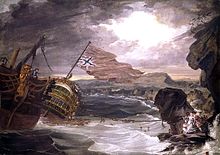Grosvenor (ship)
The Grosvenor was an East Indiaman who was shipwrecked on August 4, 1782 with an official cargo worth 300,000 pounds sterling off the South African east coast near what is now Port St. Johns . The Grosvenor was over 40 m long, had a loading capacity of 729 tons and was armed with 26 cannons . She was in October 1770 from the run stack and the track had four times before their last trip England - India and drive back. About 100 years later, Port Grosvenor opened near the site of the accident , but was soon abandoned.
The last ride
On June 3, 1780, the Grosvenor ran from Portsmouth under the command of Captain John Coxon to sail via Rio de Janeiro to Madras . From there she went on the return journey. On June 3, 1782, she left the port of Trincomalee on the east coast of Sri Lanka . There were about 138 people on board, including the crew. This also included 12 adult passengers , some of them women, with their servants and six children. In addition to the official cargo worth 300,000 pounds sterling at the time, other valuable cargo was suspected, as it was common at the time for officers and crew members of the East India Company to also carry private cargo.
The downfall
Shortly after Madagascar passed, a heavy wind came up. Because of his inaccurate sea charts , Captain Coxon suspected that he was at least 300 nautical miles east of the African coast . The wind increased towards evening, and the sails had to be hauled in during the first watch between 8 p.m. and midnight . Sailors observed two lights that appeared to be in the air, but disappeared after a while. As it turned out later, the fires were bushfires, which apparently disappeared when the hills on the African coast obscured the inland bushfires . On board it was assumed that it was a kind of aurora borealis. Around 3:30 a.m., one sailor believed he had seen land, and around 4 a.m. other sailors also recognized land. The called captain ordered to turn away, meanwhile the surf was clearly visible. Shortly afterwards the Grosvenor ran into a reef about 150 m offshore ; the ship began to fill up. Towards morning three of the crew swam to the coast to attach a lifeline; one of the men drowned. With this lifeline several people managed to reach the country, but several could not hold on and drowned. The ship meanwhile broke into two parts. In the late afternoon, the stern on which most of the people were, was driven landward into a shallow bay so that everyone could be brought ashore. A total of 15 people drowned.
The Odyssey of the Survivors
On the basis of his maps, Captain Coxon suspected the nearest Dutch settlement at a distance of 16 days' march south. Since the shipwreck While muskets were rescued, but no powder , he felt it was necessary to go to this settlement. Two crew members decided to stay behind and later built a stone house, the ruins of which are still visible today. The remaining 121 survivors headed south on August 7, three days after the disaster. Coxon had divided the survivors into three groups: first, a group of sailors led by Second Mate William Shaw; then a group to which all passengers, including women and children, belonged, under the command of Third Mate Thomas Beal. This group also led the sick chief mate Alexander Logie in a hammock; the remaining officers and crew, including 25 Indian sailors, formed the final third group under the command of Captain Coxon. The survivors were attacked by locals for the first time on August 9th. The following day there was another attack in which the tinder and flint were lost. The next day the drinking water supplies were used up. On August 11th, society began to disintegrate. Individuals and small groups fought their way individually through the wilderness, which was partially inhabited by hostile societies.
In the end, only six survivors made it to a Dutch settlement near what is now Port Elizabeth . Although war was raging between England and the Netherlands at the time, the Dutch governor sent a large expedition on December 21, 1782 to look for more survivors. She found seven other survivors. Among other things, all women and children were missing.
literature
- Janusz Piekałkiewicz : There is gold there. Südwest Verlag, Munich, 1971, ISBN 3-517-00323-9

